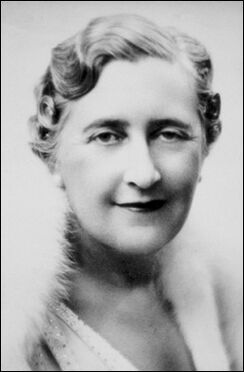
Dame Agatha Christie Mallowan, Order of the British Empire, DBE
Dame Agatha Mary Clarissa, Lady Mallowan, Order of the British Empire, DBE (15 September 1890 – 12 January 1976), commonly known as Agatha Christie, was an English crime fiction writer. She also wrote romance novels under the name Mary Westmacott , but is best remembered for her 80 detective novels and her successful West End theatre plays. Her works, particularly featuring detectives Hercule Poirot or Miss Jane Marple, have given her the title the 'Queen of Crime' and made her one of the most important and innovative writers in the development of the genre.
Christie has been called — by the Guinness Book of World Records, among others — the best-selling writer of books of all time, and the best-selling writer of any kind together with William Shakespeare. Only the Bible sold more with about 6 billion copies. An estimated four billion copies of her novels have been sold. UNESCO states that she is currently the most translated individual author in the world with only the collective corporate works of Walt Disney Productions superseding her. As an example of her broad appeal, she is the all-time best-selling author in France, with over 40 million copies sold in French (as of 2003) versus 22 million for Emile Zola, the nearest contender.
Her stage play, The Mousetrap, holds the record for the longest initial run in the world, opening at the Ambassadors Theatre in London on 25 November 1952, and as of 2014 is still running after more than 25,000 performances. In 1955, Christie was the first recipient of the Mystery Writers of America's highest honor, the Grand Master Award, and in the same year, Witness for the Prosecution was given an Edgar Award by the MWA, for Best Play. Most of her books and short stories have been filmed, some many times over, and many have been adapted for television, radio, video games and comics.
In 1998, the control of the rights to most of the literary works of Agatha Christie passed to the company Chorion, when it purchased a majority 64% share in Agatha Christie Limited.
Biography
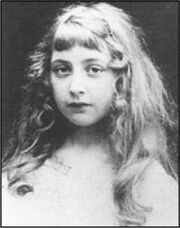
Agatha Miller
Agatha Christie was born as Agatha Mary Clarissa Miller in Torquay, Devon, to an American father and an English mother. She never claimed United States citizenship. Her father was Frederick Alvah Miller, a rich American stockbroker, and her mother was Clarissa Margaret Boehmer, the daughter of a British army captain. Christie had a sister, Margaret Frary Miller (1879 – 1950), called Madge, eleven years her senior, and a brother, Louis Montant Miller (1880 – 1929), called Monty, ten years older than Christie. Her father died when she was eleven years old. Her mother taught her at home, encouraging her to write at a very young age. At the age of 16 she went to Mrs Dryden's finishing school in Paris to study singing and piano.
Her first marriage, was in 1914 to Colonel Archibald Christie, an aviator in the Royal Flying Corps. The couple had one daughter, Rosalind Hicks , and divorced in 1928. It was during this marriage that she published her first novel in 1920, The Mysterious Affair at Styles.
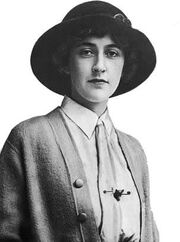
Young Agatha
During World War I she worked at a hospital and then a pharmacy, a job that influenced her work; many of the murders in her books are carried out with poison.
On 8 December 1926, while living in Sunningdale in Berkshire, she disappeared for ten days, causing great interest in the press. Her car was found in a chalk pit in Newland's Corner, Surrey. She was eventually found staying at the Swan Hydro (now the Old Swan hotel) in Harrogate under the name of Teresa Neele (Neele being the surname of Nancy Neele, the woman with whom her husband Archie had been having an affair and had asked Agatha for a divorce to enable them to marry). She claimed to have suffered a nervous breakdown and a fugue state caused by the death of her mother and her husband's infidelity. Opinions are still divided as to whether or not this is the right answer. Public sentiment at the time was negative, with many feeling that an alleged publicity stunt had cost the taxpayers a substantial amount of money.
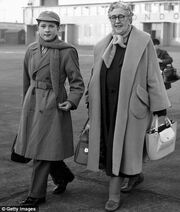
Agatha with her nephew Mathew Pritchard
A 1979 film, Agatha, starring Vanessa Redgrave as Christie, recounted an extremely fictionalised version of the disappearance. Many books have been written on the event, however none have any rock solid evidence to back up their theories, and many are very badly flawed. The best reason for her disappearence is given in Laura Thompson's biography, Agatha Christie, An English Mystery, in which she states that Christie did disappear as part of a publicity stunt, not to increase sales in her novels however, but to create a generally negative feeling towards her unfaithful husband. Unfortunately, the event was blown completely out of proportion, and instead of it creating a strong bond between Agatha and Archie as she had hoped it would, it cemented the fact that their relationship was over and could never be salvaged.
In 1930, Christie married the archaeologist Sir Max Mallowan. Mallowan was 14 years younger than Christie, and a Roman Catholic, while she was of the Anglican faith. Their marriage was an extremely happy one, and though today there is speculation that Max was unfaithful to Agatha, there is no evidence of this whatsoever. Their marriage was a wholly happy one, during which Agatha wrote the vast bulk of her novels and plays, and bought her beloved summer home, Greenway .
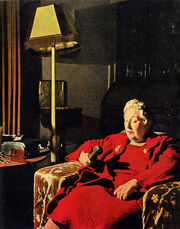
Agatha with her dictaphone
Christie's travels with Mallowan contributed background to several of her novels set in the Middle East. Other novels (such as And Then There Were None) were set in and around Torquay, Devon, where she was born. Christie's 1934 novel, Murder on the Orient Express was written in the Pera Palas hotel in Istanbul, Turkey, the southern terminus of the railroad. The hotel maintains Christie's room as a memorial to the author. The Greenway Estate in Devon, acquired by the couple as a summer residence in 1938, is now in the care of the National Trust. Christie often stayed at Abney Hall in Cheshire, which was owned by her brother-in-law, James Watts. She based at least two of her stories on the hall: The short story The Adventure of the Christmas Pudding which is in the story collection of the same name and the novel After the Funeral. "Abney became Agatha's greatest inspiration for country-house life, with all the servants and grandeur which have been woven into her plots. The descriptions of the fictional Styles , Chimneys , Stoneygates and the other houses in her stories are mostly Abney in various forms."
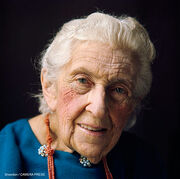
Agatha Christie, pictured at her home in 1974 by Lord Snowdon
In 1971 she was made a Dame Commander of the Order of the British Empire, an event which brought great joy to Agatha.
Agatha Christie died on 12 January 1976, at age 85, from natural causes, at her home, Winterbrook House , in the north of Cholsey parish, adjoining Wallingford in Oxfordshire (formerly Berkshire). She is buried in the nearby St Mary's Churchyard in Cholsey.
Christie's only child, Rosalind Hicks , died on 28 October 2004, also aged 85, from natural causes. Christie's grandson, Mathew Prichard, was heir to the copyright to some of his grandmother's literary work (including The Mousetrap) and is still associated with Agatha Christie Limited.
Hercule Poirot and Miss Marple
Agatha Christie's first novel The Mysterious Affair at Styles was published in 1920 and introduced the long-running character detective Hercule Poirot, who appeared in 30 of Christie's novels and 50 short stories.
Her other well known character, Miss Marple, was introduced in The Murder at the Vicarage in 1930, and was based on Christie's grandmother.
During World War II, Christie wrote two novels intended as the last cases of these two great detectives, Hercule Poirot and Jane Marple, respectively. They were Curtain and Sleeping Murder. Both books were sealed in a bank vault for over thirty years, and were released for publication by Christie only at the end of her life, when she realised that she could not write any more novels. These publications came on the heels of the success of the film version of Murder on the Orient Express in 1974.
Like Arthur Conan Doyle, Christie was to become increasingly tired of her detective, Poirot. In fact, by the end of the 1930s, Christie confided to her diary that she was finding Poirot “insufferable”, and by the 1960s she felt that he was an "an ego-centric creep". However, unlike Conan Doyle, Christie resisted the temptation to kill her detective off while he was still popular. She saw herself as an entertainer whose job was to produce what the public liked, and what the public liked was Poirot.
In contrast, Christie was fond of Miss Marple. It is however interesting to note that the Belgian detective’s titles outnumber the Marple titles by more than two to one.
Poirot is the only fictional character to have been given an obituary in The New York Times, following the publication of Curtain 1975.
Following the great success of Curtain, Christie gave permission for the release of Sleeping Murder sometime in 1976, but died in January 1976 before the book could be released. This may explain some of the inconsistencies in the book with the rest of the Marple series — for example, Colonel Arthur Bantry, husband of Miss Marple's friend, Dolly, is still alive and well in Sleeping Murder (which, like Curtain, was written in the 1940s) despite the fact he is noted as having died in books that were written after but published before the posthumous release of Sleeping Murder in 1976 — such as, The Mirror Crack'd from Side to Side. It may be that Christie simply did not have time to revise the manuscript before she died. Miss Marple fared better than Poirot, since after solving the mystery in Sleeping Murder, she returns home to her regular life in St. Mary Mead.
On an edition of Desert Island Discs in 2007, Brian Aldiss recounted how Agatha Christie told him that she wrote her books up to the last chapter, and then decided who the most unlikely suspect was. She would then go back and make the necessary changes to "frame" that person.
Archaeology and Agatha Christie
Christie had always had an interest in archaeology.
- -Christie expressing her interest in archaeology, a passage from An Autobiography (London, 1984), p. 389
On a trip to the excavation site at Ur in 1930, she met her future husband, Sir Max Mallowan, a distinguished archaeologist, but her fame as an author far surpassed his fame in archaeology. Prior to meeting Mallowan, Christie had not had any extensive brushes with archaeology, but once the two married they made sure to only go to sites where they could work together.
- -Christie wishing for an earlier exposure to Archaeology, a passage from An Autobiography (1984), p. 546
While accompanying Mallowan on countless archaeological trips (spending up to 3–4 months at a time in Syria and Iraq at excavation sites at Ur, Ninevah, Tell Arpachiyah, Chagar Bazar, Tell Brak, and Nimrud), Christie not only wrote novels and short stories, but also contributed work to the archaeological sites, more specifically to the archaeological restoration and labeling of ancient exhibits which includes tasks such as cleaning and conserving delicate ivory pieces, reconstructing pottery, developing photos from early excavations which later led to taking photographs of the site and its findings, and taking field notes.
So as to not influence the funding of the archaeological excavations, Christie would always pay for her own board and lodging and her travel expenses, and supported excavations as an anonymous sponsor.
After WW2, she chronicled her time in Syria with fondness in Come, Tell Me How You Live. Anecdotes, memories, funny episodes, are strung in a rough timeline, with more emphasis on eccentric characters, lovely scenery, than factual accuracy.
Archaeological influences found in her writing
Many of the settings for Agatha Christie’s books were directly inspired by the many archaeological field seasons spent in the Middle East on the sites managed by her second husband Max Mallowan. Her time spent at the many locations featured in her books is very apparent by the extreme detail in which she describes them. One such site featured in her books is the temple site of Abu Simbel in her book Death on the Nile, as well as the great detail in which she describes life at the dig site in her book Murder in Mesopotamia.
- Characters
Of the characters in her books, Christie has often showcased the archaeologist and experts in Middle Eastern cultures and artifacts. Most notably are the characters of Dr. Eric Leidner in Murder in Mesopotamia, Signor Richetti in Death on the Nile, and many minor characters in They Came to Baghdad were archaeologists.
More indirectly, Christie’s famous character of Hercule Poirot can be compared to an archaeologist in his detailed scrutiny of all facts both large and small. Cornelius Holtorf, an academic archaeologist, describes an archaeologist as a detective as one of the key themes of archaeology in popular culture. He describes an archaeologist as a professional detective of the past who has the ability to reveal secrets for the greater of society. Holtorf’s description of the archaeologist as a detective is very similar to Christie’s Poirot who is hugely observant and is very careful to look at the small details as they often impart the most information. Many of Christie’s detective characters show some archaeological traits through their careful attention to clues and artifacts alike. Miss Marple, another of Christie’s most famous characters, shares these characteristics of careful deduction though the attention paid to the small clues.
- Spiritual and Religious
Christie’s life within the archaeological world not only shaped her settings and characters for her books but also in the issues she highlights. One of the stronger influences is her love of the mystical and mysterious. Many of Christie’s books and short stories both set in the Middle East and back in England have a decidedly otherworldly influence in which religious sects, sacrifices, ceremony, and seances play a part. Such stories include “The Hound of Death” and “The Idol House of Astarte". This theme was greater strengthened by Christie’s time spent in the Middle East where she was consistently surrounded by the religious temples and spiritual history of the towns and cities they were excavating in Mallowan’s archaeological work.
- Travel as Adventure
During Christie and Mallowan's time in the Middle East, along with their time spent among the many tombs, temples, and museums, there was also a large amount of time spent traveling to and from Mallowan's sites. The travelling involved in the archaeology had a large influence on Christie's writing, which is often reflected as some type of transportation playing a part in her murderer’s schemes. The large amount of travel done by Christie and Mallowan has not only made for a great writing theme, as shown in her famous novel: Murder on the Orient Express, but also tied into the idea of archaeology as an adventure that has become so important in today’s popular culture as described by Cornelius Holtorf in his book Archaeology is a Brand.
Popular novels with heavy archaeological influences
- Christie’s Murder in Mesopotamia is the most archaeologically influenced of all her novels as it is set in the Middle East at an archaeological dig site and associated expedition house. The Main characters included an archaeologist, Dr. Eric Leidner, as well as his wife, multiple specialists, assistants and the men working the site. The novel is most noted for its careful description of the dig site and house, which showed the author had spent much of her own time in very similar situations herself. The characters in this book in particular are also based on archaeologists Christie knew from her personal experiences on excavations sites.
- Appointment with Death is set in Jerusalem and its surrounding area. The death itself occurs in at an old cave site and offers some very descriptive details of sites which Christie herself would have visited in order to write the book.
- Death on the Nile takes place on a tour boat on the Nile. Many archaeological sites are visited along the way and one of the main characters is an archaeologist, Signor Richetti.
- They Came to Baghdad was inspired by Christie's own trips to Baghdad with Mallowan, and involves an archaeologist as the heroine's love interest.
Miscellaneous
From 8 November 2001 - 24 March 2002, an exhibit named Agatha Christie and Archaeology: Mystery in Mesopotamia, which presented a fascinating look at the secret life of Agatha Christie and the influences of archaeology in her life and works ran in the British Museum. In 1971 Agatha Christie was made a Dame Commander of the Most Excellent Order of the British Empire. She and her second husband, Sir Max Mallowan, were one of the rare married couples to be titled, each in their own right.
In Popular Culture
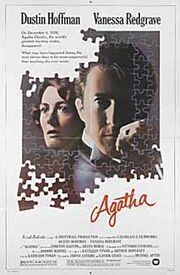
Poster for 'Agatha'
Christie has been portrayed on a number of occasions in film and television. Several biographical programs have been made, such as the 2004 BBC television programme entitled Agatha Christie: A Life in Pictures, in which she is portrayed by Olivia Williams, Anna Massey, and Bonnie Wright.
Christie has also been portrayed fictionally. Some of these have explored and offered accounts of Christie's disappearance in 1926, including the 1979 film Agatha (with Vanessa Redgrave, where she sneaks away to plan revenge against her husband) and the Doctor Who episode The Unicorn and the Wasp (with Fenella Woolgar, her disappearance being the result of her suffering a temporary breakdown due to a brief psychic link being formed between her and an alien). Others, such as 1980 Hungarian film, Kojak Budapesten (not to be confused with the 1986 comedy by the same name) create their own scenarios involving Christie's criminal skill. In the 1986 TV play, Murder by the Book, Christie herself (Dame Peggy Ashcroft) murdered one of her fictional-turned-real characters, Poirot. The heroine of Liar-Soft's 2008 visual novel Shikkoku no Sharnoth: What a Beautiful Tomorrow, Mary Clarissa Christie, is based on the real-life Christie. Christie features as a character in Gaylord Larsen's Dorothy and Agatha and The London Blitz Murders' by Max Allan Collins.
Christie has also been parodied on screen, such as in the film Murder by Indecision, which featured the character "Agatha Crispy".
List of works
Novels
Collections of Short Stories
In addition to her novels, Christie published 150 short stories in her career. Almost all of these were written for publication in fiction magazines with over half of them first appearing in the 1920s. They were then published in book form in various collections, some of which were identical in the UK and US (e.g. The Labours of Hercules) and others where publication took place in one market but not the other.
Twelve of the stories which were published in The Sketch magazine in 1924 under the sub-heading of The Man who was No. 4 were joined in one continuous narrative in the novel The Big Four in 1927. Four other stories, "The Submarine Plans" (1923), "Christmas Adventure" (1923), "The Mystery of the Baghdad Chest" (1932) and "The Second Gong" (1932), were expanded into longer narratives by Christie (respectively The Incredible Theft, The Adventure of the Christmas Pudding, The Mystery of the Spanish Chest and Dead Man's Mirror, although the shorter versions of all four have also been published in the UK).
Only one short story remains unpublished in the UK in book form: "Three Blind Mice" (1948), on which Christie placed a moratorium whilst the stage play based on the story, The Mousetrap, was still running in the West End. Prior to this the story was published in four installments in the weekly magazine Woman's Own in the issues dated December 31, 1948 to January 21, 1949 with illustrations by K. J. Petts.
In the US, the story "Christmas Adventure" can be found in both The Harlequin Tea Set and Other Stories (1997) as well as in the collection Double Sin (1961) under the title "The Theft of the Royal Ruby".
The main collections in both markets are:
- 1922 Poirot Investigates (Eleven short stories in the UK, fourteen in the US)
- 1929 Partners in Crime (Fifteen short stories; featuring Tommy and Tuppence)
- 1930 The Mysterious Mr. Quin (Twelve short stories; introducing Mr. Harley Quin)
- 1932 The Thirteen Problems (Thirteen short stories; featuring Miss Marple. Published as The Tuesday Club Murders in the US.)
- 1933 The Hound of Death (Twelve short stories –UK only)
- 1934 The Listerdale Mystery (Twelve short stories –UK version, US version published in 2010 in eBook format only)
- 1934 Parker Pyne Investigates (Twelve short stories; introducing Parker Pyne and Ariadne Oliver. Published as Mr. Parker Pyne, Detective in the US.)
- 1937 Murder in the Mews (Four novella-length stories; featuring Hercule Poirot. Published as Dead Man's Mirror in the US, but without The Incredible Theft.)
- 1939 The Regatta Mystery and Other Stories (Nine short stories –US only)
- 1947 The Labours of Hercules (Twelve short stories; featuring Hercule Poirot)
- 1948 The Witness for the Prosecution and Other Stories (Eleven short stories –US only)
- 1950 Three Blind Mice and Other Stories (Nine short stories –US only)
- 1951 The Under Dog and Other Stories (Nine short stories –US only)
- 1960 The Adventure of the Christmas Pudding (Six short stories –UK version, US version published in 2004)
- 1961 Double Sin and Other Stories (Eight short stories –US only)
- 1971 The Golden Ball and Other Stories (Fifteen short stories –US only)
- 1974 Poirot's Early Cases (Eighteen short stories. Published as Hercule Poirot's Early Cases in the US.)
- 1979 Miss Marple's Final Cases and Two Other Stories (Eight short stories –UK and Commonwealth Countries only)
- 1984 Hercule Poirot's Casebook (Fifty short stories: fourteen from Poirot Investigates, all twelve from The Labours of Hercules, eight from The Under Dog and Other Stories, five from The Regatta Mystery and Other Stories, all four from Murder in the Mews, four from Double Sin and Other Stories, and three from Three Blind Mice and Other Stories)
- 1991 Problem at Pollensa Bay and Other Stories (Eight short stories –UK and Commonwealth Countries only)
- 1997 The Harlequin Tea Set (Nine short stories –US only)
- 1997 While the Light Lasts and Other Stories (Nine short stories –UK and Commonwealth Countries only)
In addition, various collections have been published over the years which re-print short stories which have previously appeared in other collections - e.g. Surprise, Surprise! (1965 in the US). On occasion, besides the reprinted material these collections have sometimes contained the first book printing of an individual story - e.g. The Market Basing Mystery in the UK version of Thirteen for Luck! (1966) which later appeared in the same market in Poirot's Early Cases.
Novels written as Mary Westmacott
- 1930 Giant's Bread
- 1934 Unfinished Portrait
- 1944 Absent in the Spring
- 1948 The Rose and the Yew Tree
- 1952 A Daughter's a Daughter
- 1956 The Burden
Plays
- 1930 Black Coffee
- 1943 And Then There Were None
- 1945 Appointment with Death
- 1946 Murder on the Nile/Hidden Horizon
- 1951 The Hollow
- 1951 A Daughter's a Daughter (Written in the late 1930's. Performed once. Unpublished and later turned into the 1952 Mary Westmacott novel)
- 1952 The Mousetrap
- 1953 Witness for the Prosecution
- 1954 Spider's Web
- 1956 Towards Zero (Based on the 1944 novel Towards Zero )
- 1958 Verdict
- 1958 The Unexpected Guest
- 1960 Go Back for Murder
- 1962 Rule of Three (Comprised of Afternoon at the Seaside, The Rats and The Patient)
- 1972 Fiddler's Three (Originally written as Fiddler's Five. Unpublished.)
- 1973 Akhnaton (Written in 1937)
- 2003 Chimneys (Written in 1931, but unperformed for 72 years. Unpublished.)
Radio Plays
- 1937 Yellow Iris (Based on the short story of the same name)
- 1947 Three Blind Mice (Christie's celebrated stage play The Mousetrap was based on this radio play)
- 1948 Butter In a Lordly Dish
- 1960 Personal Call (A BBC Radio recording of this play is known to exist)
Television Plays
- 1937 Wasp's Nest (Based on the short story of the same name)
Nonfiction
Other published works
- 1925 The Road of Dreams (Poetry)
- 1965 Star Over Bethlehem and other stories (Christian stories and poems)
- 1973 Poems
Co-authored works
- 1930 Behind The Screen. A radio serial written together with Hugh Walpole, Dorothy L. Sayers, Anthony Berkeley, E. C. Bentley and Ronald Knox of the Detection Club. Published in book form in 1983 in The Scoop and Behind The Screen.
- 1931 The Scoop. A radio serial written together with Dorothy L. Sayers, E. C. Bentley, Anthony Berkeley, Freeman Wills Crofts and Clemence Dane of the Detection Club. Published in book form in 1983 in The Scoop and Behind The Screen.
- 1931 The Floating Admiral. A book written together with G. K. Chesterton, Dorothy L. Sayers and certain other members of the Detection Club.
- 1956 Towards Zero (A West End theatre dramatization of her 1944 novel co-written with Gerard Verner)
Other works based on Christie's books and plays
Plays adapted into novels by Charles Osborne
- 1998 Black Coffee
- 1999 The Unexpected Guest
- 2000 Spider's Web
Plays adapted by other authors
- 1928 Alibi (dramatised by Michael Morton from the novel The Murder of Roger Ackroyd)
- 1932 Roads of Memory (dramatised by W E Fuller; it is unclear what work this "sophisticated mystery" was based on)
- 1936 Love from a Stranger (dramatised by Frank Vosper from the short story Philomel Cottage)
- 1939 Tea for Three (dramatised by Margery Vosper from the short story Accident)
- 1940 Peril at End House (dramatised by Arnold Ridley)
- 1949 Murder at the Vicarage (dramatised by Moie Charles and Barbara Toy)
- 1956 Towards Zero (dramatised by Gerald Verner)
- 1977 A Murder is Announced (dramatised by Leslie Darbon)
- 1981 Cards on the Table (dramatised by Leslie Darbon)
- 1993 Murder Is Easy (dramatised by Clive Exton)
- 2005 And Then There Were None (dramatised by Kevin Elyot from the novel And Then There Were None)
- 2012 The Mysterious Affair at Styles (dramatised by David Hansen from the novel The Mysterious Affair st Styles)
Film adaptations
| Year | Title | Story based on | Notes |
|---|---|---|---|
| 1928 | The Passing of Mr. Quinn | The Coming of Mr. Quin | First Christie film adaptation |
| 1929 | Die Abenteurer G.m.b.H. | The Secret Adversary | First Christie foreign film adaptation. German adaptation of The Secret Adversary |
| 1931 | Alibi | The stage play Alibi and the novel The Murder of Roger Ackroyd | First Christie film adaptation to feature Hercule Poirot |
| 1931 | Black Coffee | Black Coffee | |
| 1932 | Le Coffret de Laque | Black Coffee | French adaptation of Black Coffee |
| 1934 | Lord Edgware Dies | Lord Edgware Dies | |
| 1937 | Love from a Stranger | The stage play Love from a Stranger and the short story "Philomel Cottage" | Released in the US as A Night of Terror |
| 1945 | And Then There Were None | The stage play And Then There Were None and the novel And Then There Were None | First Christie film adaptation of And Then There Were None |
| 1947 | Love from a Stranger | The stage play Love from a Stranger and the short story "Philomel Cottage" | Released in the UK as A Stranger Walked In |
| 1957 | Witness for the Prosecution | The stage play Witness for the Prosecution and the short story "The Witness for the Prosecution" | |
| 1960 | The Spider's Web | Spider's Web | |
| 1961 | Murder, She Said | 4.50 from Paddington | First Christie film adaptation to feature Miss Marple |
| 1963 | Murder at the Gallop | After the Funeral | In the film, Miss Marple replaces Hercule Poirot |
| 1964 | Murder Most Foul | Mrs McGinty's Dead | The film is loosely based on the book and as a major change Miss Marple replaces Hercule Poirot |
| 1964 | Murder Ahoy! | None | An original film, not based on any book, although it borrows some elements of They Do It with Mirrors |
| 1965 | Gumnaam | And Then There Were None | Uncredited adaptation of And Then There Were None |
| 1965 | Ten Little Indians | The stage play And Then There Were None and the novel And Then There Were None | |
| 1965 | The Alphabet Murders | The A.B.C. Murders | |
| 1972 | Endless Night | Endless Night | |
| 1973 | Dhund | The Unexpected Guest | Dhund (translation: Fog) is a 1973 Hindi movie produced and directed by B. R. Chopra |
| 1974 | Murder on the Orient Express | Murder on the Orient Express | Arguably the most successful adaption of any Christie's work's, being nominated for 6 Academy Awards and winnig one |
| 1974 | And Then There Were None | The stage play And Then There Were None and the novel And Then There Were None | Released in the US as Ten Little Indians |
| 1978 | Death on the Nile | The stage play Murder on the Nile and the novel Death on the Nile | |
| 1980 | The Mirror Crack'd | The Mirror Crack'd from Side to Side | |
| 1982 | Evil Under the Sun | Evil Under the Sun | |
| 1985 | Ordeal by Innocence | Ordeal by Innocence | |
| 1987 | Desyat Negrityat | The stage play And Then There Were None and the novel And Then There Were None | Russian film adaptation of And Then There Were None |
| 1988 | Appointment with Death | The stage play Appointment with Death and the novel Appointment with Death | |
| 1989 | Ten Little Indians | The stage play And Then There Were None and the novel And Then There Were None | |
| 1995 | Innocent Lies | Towards Zero | |
| 2005 | Mon petit doigt m'a dit... | By the Pricking of My Thumbs | French adaptation of By the Pricking of My Thumbs |
| 2007 | L'Heure zéro | Towards Zero | French adaptation of Towards Zero |
| 2008 | Le crime est notre affaire | 4.50 from Paddington | French adaptation of 4.50 from Paddington |
| 2012 | Grandmaster | The A.B.C. Murders |
Indian(Malayalam) adaptation of The A.B.C Murders |
Television
- 1937 Spider's Web (Based on the stage play of the same name)
- 1938 Love from a Stranger (Based on the stage play of the same name from the short story Philomel Cottage)
- 1947 Love from a Stranger
- 1949 Ten Little Indians
- 1959 Ten Little Indians
- 1970 The Murder at the Vicarage
- 1980 Why Didn't They Ask Evans?
- 1982 Spider's Web
- 1982 The Seven Dials Mystery
- 1982 The Agatha Christie Hour
- 1982 Murder Is Easy
- 1982 The Witness for the Prosecution
- 1983 The Secret Adversary
- 1983 Partners in Crime
- 1983 A Caribbean Mystery
- 1983 Sparkling Cyanide
- 1984 The Body in the Library
- 1985 Murder with Mirrors
- 1985 The Moving Finger
- 1985 A Murder is Announced
- 1985 A Pocket Full of Rye
- 1985 Thirteen at Dinner
- 1986 Dead Man's Folly
- 1986 Murder in Three Acts
- 1986 The Murder at the Vicarage
- 1987 Sleeping Murder
- 1987 At Bertram's Hotel
- 1987 Nemesis
- 1987 4.50 from Paddington
- 1989 The Man in the Brown Suit
- 1989 A Caribbean Mystery
- 1991 They Do It with Mirrors
- 1992 The Mirror Crack'd from Side to Side
- 1997 The Pale Horse
- 2001 Murder on the Orient Express
- 2003 Sparkling Cyanide
- 2004 The Body in the Library
- 2004 The Murder at the Vicarage
- 2004 4.50 from Paddington
- 2005 A Murder is Announced
- 2005 Sleeping Murder
- 2006 The Moving Finger
- 2006 By the Pricking of My Thumbs
- 2006 The Sittaford Mystery
- 2007 Hercule Poirot's Christmas (A French film adaptation)
- 2007 Towards Zero
- 2007 Nemesis
- 2007 At Bertram's Hotel
- 2007 Ordeal by Innocence
- 2009 A Pocket Full of Rye
- 2009 Murder Is Easy
- 2009 They Do It with Mirrors
- 2009 Why Didn't They Ask Evans?
- 2010 The Mirror Crack'd from Side to Side
- 2010 The Secret of Chimneys
- 2010 The Blue Geranium
- 2010 The Pale Horse
- 2013 A Caribbean Mystery
- 2013 Greenshaw's Folly
- 2013 Endless Night
Agatha Christie's Poirot television series
Episodes of the television series Agatha Christie's Poirot include:
- 1990 Peril at End House
- 1990 The Mysterious Affair at Styles
- 1992 The ABC Murders
- 1992 Death in the Clouds
- 1992 One, Two, Buckle My Shoe
- 1994 Hercule Poirot's Christmas
- 1995 Murder on the Links
- 1995 Hickory Dickory Dock
- 1996 Dumb Witness
- 2000 The Murder of Roger Ackroyd
- 2000 Lord Edgware Dies
- 2001 Evil Under the Sun
- 2001 Murder in Mesopotamia
- 2004 Five Little Pigs
- 2004 Death on the Nile
- 2004 Sad Cypress
- 2004 The Hollow
- 2005 The Mystery of the Blue Train
- 2005 Cards on the Table
- 2005 After the Funeral
- 2006 Taken at the Flood
- 2008 Mrs. McGinty's Dead
- 2008 Cat Among the Pigeons
- 2008 Third Girl
- 2008 Appointment with Death
- 2009 The Clocks
- 2009 Three Act Tragedy
- 2010 Hallowe'en Party
- 2010 Murder on the Orient Express
- 2013 Elephants Can Remember
- 2013 The Big Four
- 2013 The Labours of Hercules
- 2013 Dead Man's Folly
- 2014 Curtain
Graphic novels
Euro Comics India began issuing a series of graphic novel adaptations of Christie's work in 2007.
- 2007 The Murder on the Links. Adapted by François Rivière, illustrated by Marc Piskic
- 2007 Murder on the Orient Express. Adapted by François Rivière, illustrated by Solidor (Jean-François Miniac).
- 2007 Death on the Nile. Adapted by Francois Riviere, illustrated by Solidor (Jean-François Miniac)
- 2007 The Secret of Chimneys. Adapted by François Rivière, illustrated by Laurence Suhner
- 2007 The Murder of Roger Ackroyd. Adapted and illustrated by Bruno Lachard
- 2007 The Mystery of the Blue Train. Adapted and illustrated by Marc Piskic
- 2007 The Man in the Brown Suit. Adapted and illustrated by Alain Paillou
- 2007 The Big Four. Adapted by Hichot and illustrated by Bairi
- 2007 The Secret Adversary. Adapted by François Rivière and illustrated by Frank Leclercq
- 2007 The Murder at the Vicarage. Adapted and illustrated by "Norma"
- 2007 The Murder on the Links Adapted and illustrated by François Rivière, Marc Piskic
- 2007 Murder in Mesopotamia. Adapted by François Rivière and illustrated by Chandre
- 2007 And Then There Were None. Adapted by François Rivière and illustrated by Frank Leclercq
- 2007 Endless Night. Adapted by Francois Rivière and illustrated by Frank Leclercq
- 2008 Ordeal by Innocence. Adapted and illustrated by Chandre
- 2008 Hallowe'en Party. Adapted and illustrated by Chandre
- 2008 Peril at End House Adapted by Thierry Jollet and illustrated by Didier Quella-Guyot
- 2009 Dumb Witness Adapted and illustrated by "Marek"
- 2010 Cards On the Table Adapted and illustrated by Frank Leclercq
- 2010 Five Little Pigs Adapted by Miceal O'Griafa, David Charrier
- 2012 Dead Man's Folly Adapted and illustrated by Marek
- 2013 Evil Under the Sun Adapted by Thierry Jollet and illustrated by Didier Quella-Guyot
Video games
- 1988 The Scoop (published by Spinnaker Software and Telarium) (PC)
- 2005 Agatha Christie: And Then There Were None (PC and Wii).
- 2006 Agatha Christie: Murder on the Orient Express (PC)
- 2007 Agatha Christie: Death on the Nile (I-Spy" hidden-object game) (PC)
- 2007 Agatha Christie: Evil Under the Sun (PC and Wii)
- 2008 Agatha Christie: Peril at End House (I-Spy" hidden-object game)
- 2009 Agatha Christie: The ABC Murders (DS)
- 2009 Agatha Christie: Dead Man's Folly (I-Spy" hidden-object game)(PC)
- 2010 Agatha Christie 4:50 from Paddington (I-Spy" hidden-object game)(PC)
Unpublished Material
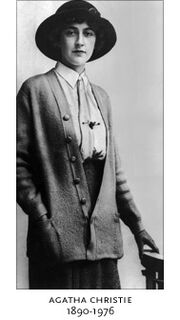
- Personal Call (supernatural radio play, featuring Inspector Narracott who also appeared in The Sittaford Mystery; a recording is in the British Library Sound Archive)
- The Woman and the Kenite (horror; a translation, from an Italian magazine of the 1920s):
- Butter In a Lordly Dish (horror/detective radio play, adapted from The Woman and the Kenite)
- Being So Very Wilful (romantic)
- Snow Upon the Desert (romantic novel)
- Stronger than Death (supernatural)
- The Green Gate (supernatural)
- The Greenshore Folly (novella featuring Hercule Poirot; the basis for Dead Man's Folly)
- The War Bride (supernatural)
- Eugenia and Eugenics (stage play)
- Witchhazel (supernatural short story)
- Someone at the Window (play adapted from short story The Dead Harlequin)
- Miss Perry (stage play)
Animation
In 2004, the Japanese broadcasting company Nippon Housou Kyoukai turned Poirot and Marple into animated characters in the anime series Agatha Christie's Great Detectives Poirot and Marple, introducing Mabel West (daughter of Miss Marple's mystery-writer nephew Raymond West, a canonical Christie character) and her duck Oliver as new characters.








